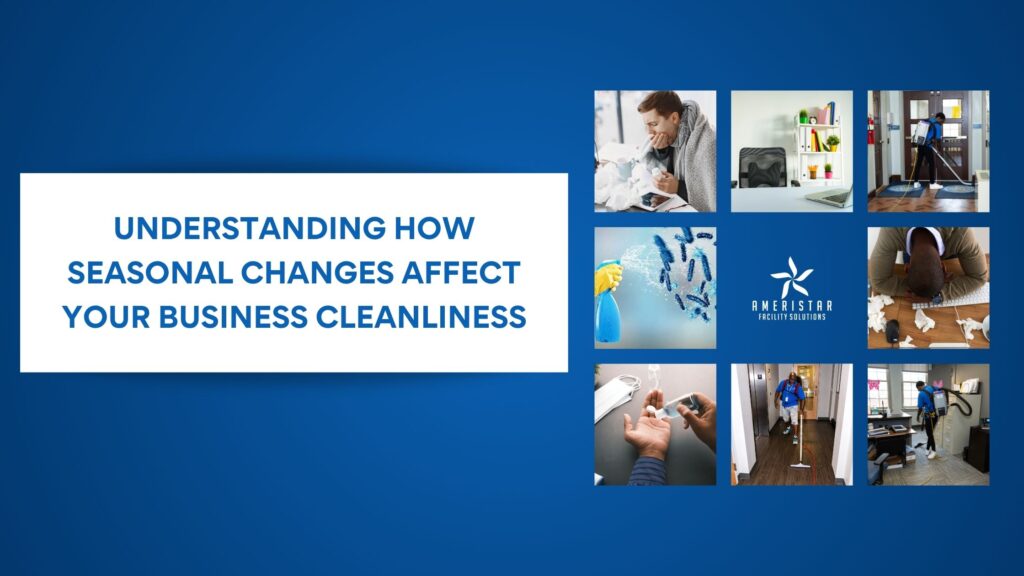When you think about cleaning your facility, you might focus on checklists, supply closets, and schedules. But there’s one factor that often gets overlooked, and it affects everything: the seasons.
Each time the weather changes, so do the conditions inside and outside your building. From dry winter air to summer humidity, seasonal shifts quietly impact how clean, safe, and functional your facility feels.
Here’s why understanding those changes matters, and how to adapt your cleaning strategy accordingly:
How Seasonal Shifts Impact Your Environment
Your facility doesn’t exist in a vacuum. Weather patterns outside directly influence conditions inside, from air quality to flooring wear and tear. Failing to adjust your cleaning practices with the seasons can lead to more maintenance issues, lower employee satisfaction, and even health concerns.
Let’s break it down season by season.
Spring: Allergens and Air Quality
Spring may be beautiful, but for many buildings, it’s allergy season. Here’s what happens:
– Trees and flowers release pollen, which enters through open windows and doors.
– Mold spores increase with spring rains and warmer temperatures.
– Dust and debris build up from winter’s end.
Cleaning priorities:
– Dust frequently using a microfiber cloth.
– Replace HVAC filters and clean vents.
– Wipe down windows, blinds, and ledges.
– Power wash building exteriors and entryways.
.
Spring is also an ideal time for a thorough clean. You’re resetting your space for a more active, energized season, so make sure your cleaning reflects that.
Summer: Heat, Humidity, and Heavy Foot Traffic
Summer brings sunshine and a whole lot of dirt, moisture, and foot traffic. Here’s what changes:
– High humidity raises the risk of mold and musty odors.
– Break rooms and restrooms need more frequent cleaning due to bacterial growth.
– Sand, grass, and dust are tracked in more easily.
– HVAC systems work overtime, impacting air quality.
What to prioritize:
– Deep clean carpets and strip/wax hard floors.
– Disinfect high-touch surfaces and shared equipment more often.
– Monitor and manage moisture-prone areas (restrooms, basements, under sinks).
– Schedule regular HVAC and vent cleanings.
Summer is also the time when many staff members take vacations, which can lead to inconsistent cleaning schedules. Automating or outsourcing key tasks ensures nothing gets missed.
Fall: Leaves, Dampness, and Transition Prep
Fall is often a transitional season, but that doesn’t mean your cleaning plan should take a backseat. Here’s what happens:
– Wet leaves get dragged inside and stick to the floors.
– Cooler weather means closed windows and stale indoor air.
– People bring in extra layers, backpacks, and umbrellas, leading to more clutter.
Key updates:
– Clean entry mats and rugs daily.
– Sweep exterior walkways and gutters frequently.
– Disinfect shared spaces as the cold season begins.
– Revisit HVAC filters as the heating system starts up.
Fall is also a great time to evaluate your cleaning inventory and prep for the demands of winter.
Winter: Salt, Slush, and Closed Spaces
Winter creates a tough environment for facilities, physically and logistically. Here’s what shifts:
– Rock salt, snow, and slush damage floors and stain carpets.
– Lower ventilation increases germ buildup indoors.
– Cold and flu season spikes absenteeism.
– Closed windows = poor air circulation and dryness.
Top cleaning strategies:
– Increase mopping and floor care to prevent damage from salt and moisture.
– Sanitize touchpoints daily (elevator buttons, door handles, communal devices).
– Monitor indoor air quality and consider humidifiers if needed.
– Schedule evening or early morning cleaning to avoid weather disruptions.
Winter often requires more frequent, focused cleaning, especially in healthcare or high-traffic environments.
Why This Matters for Your Business
Ignoring seasonal changes doesn’t just result in a dusty window or smudged floor. Over time, it can:
– Increase your repair and maintenance costs.
– Lower employee satisfaction and productivity.
– Make a poor impression on clients or guests.
– Pose health and safety risks.
Your cleaning strategy is part of your facility’s operational health. When you plan around the seasons, you’re not reacting, you’re anticipating.
How to Stay Ahead Year-Round:
1. Create a seasonal cleaning calendar:
Plan out quarterly deep cleans, HVAC maintenance, and product restocks in advance.
2. Train your staff on seasonal priorities:
From allergen control in spring to mold prevention in summer, everyone should be aware of what to look out for.
3. Partner with professionals:
Commercial cleaning services, such as AmeriStar, offer scalable support and the expertise to tailor cleaning routines to your facility and the specific season.
4. Monitor the weather:
Keep an eye on extreme weather days. Extra rain or heat may require same-day cleanups or adjusted routines.
Stay Ahead of the Seasons with Smart Janitorial Cleaning Solutions from AmeriStar Facility Solutions
Every season brings its own unique rhythm, and your cleaning strategy should adapt to it. From allergen-heavy springs to high-traffic summers and slushy winters, each shift requires specific attention and care. Understanding how seasonal changes affect your facility isn’t just about cleanliness; it’s about protecting your business, your people, and your brand.
Need help adjusting your cleaning plan with the seasons?
Call AmeriStar Facility Solutions at (570) 310-1057 or visit www.ameristarfacilitysolutions.com to schedule customized year-round services that fit your facility’s exact needs.

